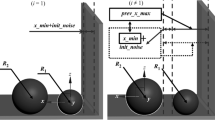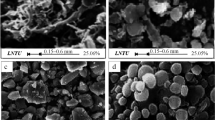This article builds the mathematical model of randomized 3D particles using a Python program to study the densification behavior of heterogeneous powder particles of non-equal diameter under pressure. The Python interface reserved by the finite element software Marc was applied to compile relevant command files and link them to carry out the numerical simulation of powder particle densification. The principles of particle distribution, deformation, and nodal flow were obtained by analyzing the powder particle compaction outcomes. The impact of particle parameters, compaction temperature, and coefficient of friction on the relative density of compacts was investigated. The results of the simulation show that the powder particles in the mould cavity are spiraling. Cu particles form concave arcs and cylindrical arcs at contact points, and the node trajectories rotate from top to bottom and from the center to the periphery. The overall deformation of Cr powder particles is not obvious. In the pressing process, the larger the powder particles, the greater the degree of deformity. As the temperature in the cavity increases, the relative density decreases. The higher the cavity friction, the higher the relative density, but once it reaches a certain value, the relative density reduces. The relative density of compacts can be greatly enhanced by selecting soft powder particles with a larger size, a higher temperature cavity, and a certain value of friction force. The experimental results verify the accuracy of the simulation, which is an important benchmark for numerical simulation of randomized particle densification. The findings provide a theoretical basis for further improvement in the density and properties of heterogeneous metal doping.











Similar content being viewed by others
References
B. Harthong, D. Imbault, and P. Doremus, “The study of relations between loading history and yield surfaces in powder materials using discrete finite element simulations,” J. Mechan. Phys. Sol. 60, No. 4, 784–801 (2012).
M.C. Zhou, S.Y. Huang, J.H. Hu, Y. Lei, F.L. Zou, S.W. Yan, and M. Yang, “Experiment and finite element analysis of compaction densification mechanism of Ag–Cu–Sn–In mixed metal powder,” Powder Technol., 313, 68–81 (2017).
C.V. Nguyen, Y. Deng, A. Bezold, and C. Broeckmann, “A combined model to simulate the powder densification and shape changes during hot isostatic pressing,” Computer Methods Appl. Mechan. Eng., 315, 302–315 (2016).
T. Watanabe, A. Yanagisawa, and T. Sasaki, “Development of Ag based brazing filler metal with low melting point,” Sci. Technol. Welding Joining, 16, No. 6, 502–508 (2011).
J. Ai, J.F. Chen, J.M. Rotter, and J.Y. Ooi, “Assessment of rolling resistance models in discrete element simulations,” Powder Technol., 206, No. 3, 269–282 (2011).
D.F. Wang, Characterization of Radical Microscopic Properties of Orderly Packed Structure of Binary Spherical Particles [in Chinese], Northeastern University (2014), pp. 1–83.
Y.X. Zhang, Multi-Particle Finite Element Simulation of Particle Micro-Behavior during Powder Compaction [in Chinese], Northeastern University (2015), pp. 1–78.
C. Li, Experimental Study on One-Dimensional and Three-Dimensional Vibration Packing Densification of Binary Size Balls [in Chinese], Northeastern University (2011), pp. 1–119.
D.W. Wolla, M.J. Davidson, and A.K. Khanra, “Prediction of ductile fracture initiation for powder metallurgical aluminum-copper preforms using FEM,” Int. J. Mechan. Mater. Eng., 10, No. 1, 8 (2015); https://doi.org/10.1186/s40712-015-0036-9
Y. Zhang and F.Z. Wang, “Numerical simulation of effects of pressure on densification of hot isostatic pressing of CuCr25 powder” [in Chinese], Hot Working Technol., 47, No. 2, 76–85 (2018).
S. Zhao, F.Z. Wang, and D.Q. Ou, “Simulation of heterogeneous powder compression deformation behavior of Cu–W” [in Chinese], Ordnance Mater. Sci. Eng., 41, No. 2, 58–62 (2018).
H.P. Chen and F.Z. Wang, “Finite element simulation of hot isostatic pressing densification process for W–Cu alloy powder” [in Chinese], Mater. Mechan. Eng., 41, No. 6, 69–74 (2017).
Q.X. Liu, F.Z. Wang, Y. Zhang, and H.P. Chen, “Numerical simulation of macro segregation and temperature field of Cu–Cr two binary alloy” [in Chinese], Mater. Sci. Technol., 24, No. 6, 73–78 (2016).
Y.B. Wang, F.Z. Wang, Y.K. Wang, Y.F. Li, and W.G. Du, “Three-dimensional numerical simulation of deformation and particle flow of Cu–Cr powder densified particles” [in Chinese], Acta Mater. Compos. Sinica., 36, No. 12, 2902–2911 (2019).
D.G. Wang, Y.C. Wu, and M.H. Jiao, “Research and simulation of influence of three-axial compaction on powder metallurgic products properties,” Acta Metall. Sinica (English Letters), 21, No. 2, 116–124 (2009).
Y.X. Zhang, X.Z. An, and Y.L. Zhang, “Multi-particle FEM modeling on microscopic behavior of 2D particle compaction,” Appl. Phys. A, 118, No. 3, 1015–1021 (2015).
A.J. Taleghanim, M.R. Navase, M. Salehi, and J.M. Torralba, “Hot deformation behaviour and flow stress prediction of 7075 aluminium alloy powder compacts during compression at elevated temperatures,” Mater. Sci. Eng. A, 534, No. 2, 624–631 (2012).
B. Guo, J. Ao, Y. Xu, and Z.J. Zhang, “Constitutive equation for the flow and densification behaviors of powder metallurgy Fe–0.5C–2Cu steel at elevated temperatures,” Steel Research Int., 88, 22–31 (2017).
C. Feng, D.D. Sun, and H.S. Chen, New Marc Example Tutorial and Common Problem Analysis [in Chinese], China Water & Power Press, Beijing (2016), pp. 225–229.
D.F. Khan, H. Yin, Z. Usman, M. Khan, X.J. Yuan, W.H. Wang, and X.H. Qu, “Improvement of a high velocity compaction technique for iron powder,” Acta Metal Lurgica Sinica (English Letters), 26, No. 4, 399–403 (2013).
A.V. Kuzmov, M.B. Shtern, and O.G. Kirkova, “Effect of billet elongation degree and strain hardening of the powder on compaction with rotating die,” Mathematical Models and Computing Experiment in Material Science: Collected Papers [in Russian], 21, 101–108 (2019).
C.V. Nguyen, Y. Deng, A. Bezold, and C. Broeckmann, “A combined model to simulate the powder densification and shape changes during hot isostatic pressing,” Computer Methods Appl. Mechan. Eng., 315, 302–315 (2016).
D.C. Tsai and W.S. Hwang, “Numerical simulation of solidification morphologies of Cu–0.6 Cr casting alloy using modified cellular automaton model,” Trans. Nonferrous Met. Soc. China, 20, No. 6, 1072–1077 (2010).
B.Y. Xu, Plastic Echanics [in Chinese], Higher Education Press, Beijing (1988), pp. 88–111.
J. Paul, S. Romeis, P. Herre, and W. Peukert, “Deformation behavior of micron-sized polycrystalline gold particles studied by in situ compression experiments and frictional finite element simulation,” Powder Technol., 286, 706–715 (2015).
F. Güner, Ö.N. Cora, and H. Sofuoglu, “Effects of friction models on the compaction behavior of copper powder,” Tribol. Int., 122, 125–132 (2018).
K.M. Arndt, S. Aman, R. Fuchs, and J. Tomas, “Contact properties determination of macroscopic fine disperse glass particle via compression tests in normal direction,” Adv. Powder Technol., 28, 101–114 (2017).
M.H. Jiao, L. Sun, M. Gu, D.G. Wang, and Y.C. Wu, “Mesoscopic simulation of the compression deformation process of powder particles,” Adv. Mater. Research., 38, No. 5, 169–173 (2013).
Author information
Authors and Affiliations
Corresponding author
Additional information
Published in Poroshkova Metallurgiya, Vol. 60, Nos. 1–2 (537), pp. 11–26, 2021.
Rights and permissions
About this article
Cite this article
Huang, K., Wang, F., Zhao, M. et al. Numerical Simulation of Densification of Heterogeneous Random Powder Particles with Non-Equal Diameter. Powder Metall Met Ceram 60, 7–19 (2021). https://doi.org/10.1007/s11106-021-00210-8
Received:
Published:
Issue Date:
DOI: https://doi.org/10.1007/s11106-021-00210-8




